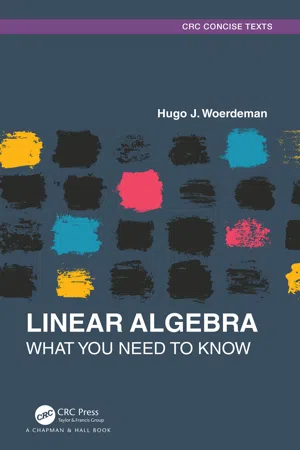
- 262 pages
- English
- ePUB (mobile friendly)
- Available on iOS & Android
About this book
There is good reason to be excited about Linear Algebra. With the world becoming increasingly digital, Linear Algebra is gaining more and more importance. When we send texts, share video, do internet searches, there are Linear Algebra algorithms in the background that make it work.
This concise introduction to Linear Algebra is authored by a leading researcher presents a book that covers all the requisite material for a first course on the topic in a more practical way.
The book focuses on the development of the mathematical theory and presents many applications to assist instructors and students to master the material and apply it to their areas of interest, whether it be to further their studies in mathematics, science, engineering, statistics, economics, or other disciplines.
Linear Algebra has very appealing features:
•It is a solid axiomatic based mathematical theory that is accessible to a large variety of students.
•It has a multitude of applications from many different fields, ranging from traditional science and engineering applications to more 'daily life' applications.
•It easily allows for numerical experimentation through the use of a variety of readily available software (both commercial and open source).
Several suggestions of different software are made. While MATLAB is certainly still a favorite choice, open-source programs such as Sage (especially among algebraists) and the Python libraries are increasingly popular. This text guides the student to try out different programs by providing specific commands.
Frequently asked questions
- Essential is ideal for learners and professionals who enjoy exploring a wide range of subjects. Access the Essential Library with 800,000+ trusted titles and best-sellers across business, personal growth, and the humanities. Includes unlimited reading time and Standard Read Aloud voice.
- Complete: Perfect for advanced learners and researchers needing full, unrestricted access. Unlock 1.4M+ books across hundreds of subjects, including academic and specialized titles. The Complete Plan also includes advanced features like Premium Read Aloud and Research Assistant.
Please note we cannot support devices running on iOS 13 and Android 7 or earlier. Learn more about using the app.
Information
1
Matrices and Vectors
CONTENTS
- 1.1 Matrices and Linear Systems
- 1.2 Row Reduction: Three Elementary Row Operations
- 1.3 Vectors in ℝn, linear combinations and span
- 1.4 Matrix Vector Product and the Equation Ax = b
- 1.5 How to Check Your Work
- 1.6 Exercises
Table of contents
- Cover
- Half Title
- Series Page
- Title Page
- Copyright Page
- Dedication
- Contents
- Preface
- Acknowledgements
- Notation
- List of Figures
- 1 Matrices and Vectors
- 2 Subspaces in ℝn, Basis and Dimension
- 3 Matrix Algebra
- 4 Determinants
- 5 Vector Spaces
- 6 Linear Transformations
- 7 Eigenvectors and Eigenvalues
- 8 Orthogonality
- Answers to Selected Exercises
- Appendix
- Index